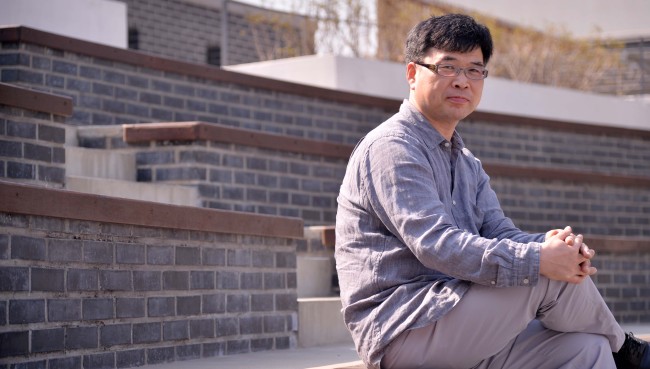The music of composer Ryu Hyeong-sun has an appeal that crosses strikingly different genres and attracts a diverse range of fans.
To young or expecting moms, he is best known for a series of pregnancy music, lullabies and children’s songs. Christians know him as a gospel musician. Among fans of gugak or traditional Korean classical music, he is regarded as one of the country’s most promising gugak composers.
Characterizing Ryu or his music by genre makes little difference to him, though. Music mirrors one’s life and vice versa, he says.
“I write music as confessions of my faith, feelings and thoughts. Some works of mine pull at the heartstrings of certain strata of audience, giving me such recognition. That’s all.”
Ryu studied Western music composition at Hanyang University. However, he was charmed by gugak at that time, so he tried writing music in gugak style. After graduating in 1992, he spent several years writing music and producing concerts and other stage performances, and later released albums.
 |
Ryu Hyeong-sun poses for a photo prior to an interview with The Korea Herald at the National Gugak Center in southern Seoul last week. (Lee Sang-sub/The Korea Herald) |
“When I got married in 1999, I thought to myself I should focus on my true musical passion: gugak,” he said.
One day while driving, he had a life-changing encounter with gugak. A piece from the pansori “Chunhyang-ga” came on the radio. The vocalist was delivering a musical dialogue between servant Banja and his master Lee Mong-ryong about the troubles facing Mong-ryong’s lover Chun Hyang.
Pansori is Korean musical storytelling or opera drama performed by a solo vocalist and a drummer. A singer performs all the characters of a story, with a drummer tapping his drum and shouting impromptu exclamations occasionally.
“I don’t remember when exactly it was or where I was heading then. But I remember pulling over and sitting there for a while, feeling overwhelmed.”
That was the moment when he vowed to learn gugak in earnest.
In 2001, he enrolled at the Korean National University of Arts to major in the genre. About 13 years later, on April 1 this year, he joined the National Gugak Center, located right next to the university, as artistic director of its Creative Music Troupe.
The troupe, an ensemble founded 10 years ago, is tasked with introducing new gugak works and reinventing the traditional Korean music genre for the changing times.
He seems to be cut out for the position, given that his past works are credited with drawing new audiences by fusing gugak with modern pop, Western classical music and many other genres.
Still, he has no intention of forcing his interest in crossover on the troupe.
“The foremost task for a creative music troupe is to establish its musical identity. Currently we are seen just as a gugak version of Western ensembles,” he said.
“There’s much to be experimented with, within gugak,” he added.
To do so, he plans to focus solely on ensemble work.
“I won’t have time to compose,” he said. He has already pulled out of all his other projects ― 12 albums to produce or participate in and eight songs commissioned for this year.
It will be a respite in his prolific career as a composer.
Sometime between 2006 and 2007, he tried to gauge his productivity. He has composed 300 minutes of music per year. Songs on K-pop charts are about three minutes long.
“I have no idea how many I have written so far. If I count only gugak pieces, the number would be maybe around 200. That excludes all my CCM (contemporary Christian music) and nongugak works,” he said.
Among his most famous works are a series of lullabies and children’s songs on his “Ja-mie Jam-ie” albums. The first, and most successful, of the five albums came out in 2004. Some of his other children’s songs are on YouTube, including the “Poop Song,” which has more than 180,000 views.
Ryu’s first and only solo album was released in 2008. The “Six-stringed Bridge Stone” has six tracks ― all fusing gugak melodies with guitar.
By Lee Sun-young (
milaya@heraldcorp.com)








